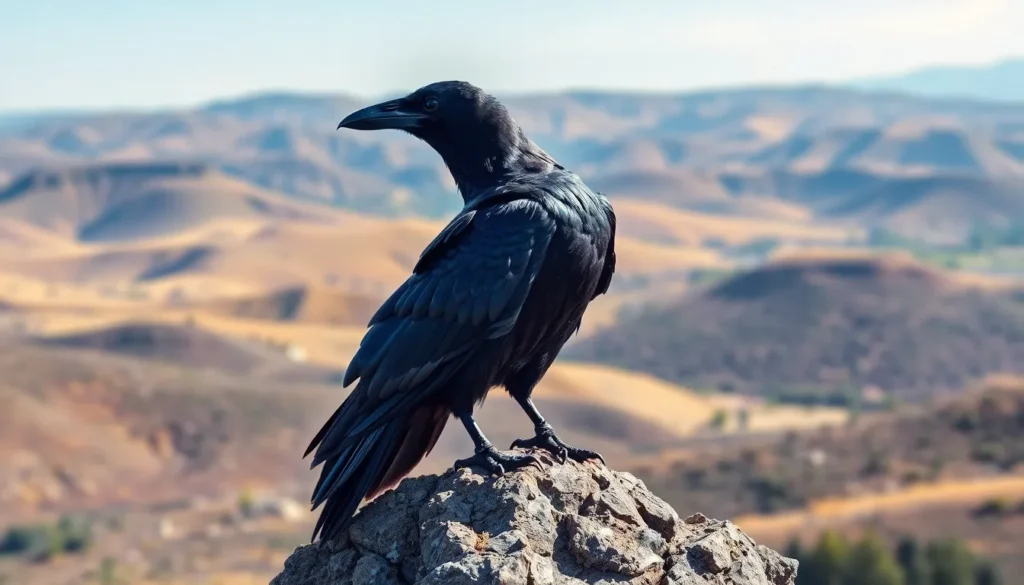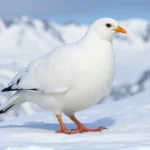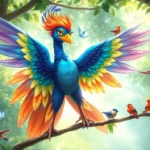Ravens have captivated our imagination for thousands of years with their mysterious black silhouettes and haunting calls. These remarkable birds aren’t just harbingers of doom from folklore – they’re among the most intelligent creatures on our planet with problem-solving abilities that rival those of young children.
We’ve discovered that ravens possess extraordinary cognitive skills including the ability to use tools plan for future events and even engage in what appears to be play behavior. Their complex social structures and sophisticated communication methods have earned them recognition as one of nature’s most fascinating species.
Whether you’re drawn to their cultural significance in mythology or amazed by their scientific prowess ravens continue to surprise researchers worldwide. Let’s explore what makes these corvids so exceptional and why they’ve earned their reputation as the Einstein of the bird industry.
Physical Characteristics of the Raven Bird
Ravens possess remarkable physical attributes that distinguish them from other corvids and make them instantly recognizable in the wild. Their imposing stature and distinctive features reflect millions of years of evolutionary adaptation.
Size and Build
Ravens rank among the largest members of the corvid family with impressive dimensions that command attention. Adult ravens measure 24 to 27 inches in length from beak to tail and weigh between 1.5 to 4.4 pounds. Their wingspan extends 46 to 53 inches across, creating a formidable silhouette during flight. Males typically exceed females in size by approximately 10 to 15 percent, though this difference becomes apparent only through direct comparison.
The raven’s robust build features a powerful chest and broad shoulders that support their strong flight muscles. Their legs appear sturdy and well-proportioned, measuring roughly 3 inches in length with sharp, curved talons designed for gripping various surfaces. These birds carry themselves with confident posture that reflects their intelligence and adaptability.
Distinctive Features
The raven’s massive bill serves as their most recognizable feature, measuring 2.5 to 3.3 inches in length with a slight downward curve at the tip. This powerful beak functions as a multi-tool for cracking nuts, tearing meat, and manipulating objects during problem-solving activities. Black bristles cover the bill’s base, extending over the nostrils and creating a distinctive textured appearance.
Their wedge-shaped tail distinguishes ravens from crows and other similar birds during flight. The tail feathers form a diamond or triangular shape when spread, contrasting sharply with the square or rounded tails of their smaller relatives. Ravens also possess longer, more pointed wings that enable soaring behavior uncommon among other corvids.
The bird’s head appears proportionally large with a pronounced forehead that houses their remarkable brain. Their dark eyes exhibit high intelligence and alertness, often described as penetrating or knowing by observers. Ravens can live 15 to 20 years in the wild, with some captive individuals reaching over 40 years of age.
Plumage and Coloration
Raven plumage creates a stunning visual display that shifts between deep black and iridescent hues depending on lighting conditions. Their feathers reflect blue, green, and purple tones when sunlight strikes at certain angles, creating an almost metallic appearance. This iridescence results from microscopic structures in the feather barbules that refract light wavelengths.
Adult ravens maintain uniform coloration across their entire body, from their sleek head feathers to their wing tips and tail. Juvenile ravens display slightly duller plumage with less pronounced iridescence, gradually developing the full adult coloration over their first year. Their feathers grow densely packed, providing excellent insulation against harsh weather conditions in their diverse habitats.
The raven’s throat feathers appear elongated and pointed, creating a shaggy or beard-like appearance that becomes more pronounced when the bird vocalizes. These specialized feathers can be erected or flattened to change the bird’s appearance during social interactions or territorial displays. Ravens molt their feathers gradually throughout the year, ensuring continuous flight capability while maintaining their distinctive appearance.
Habitat and Distribution
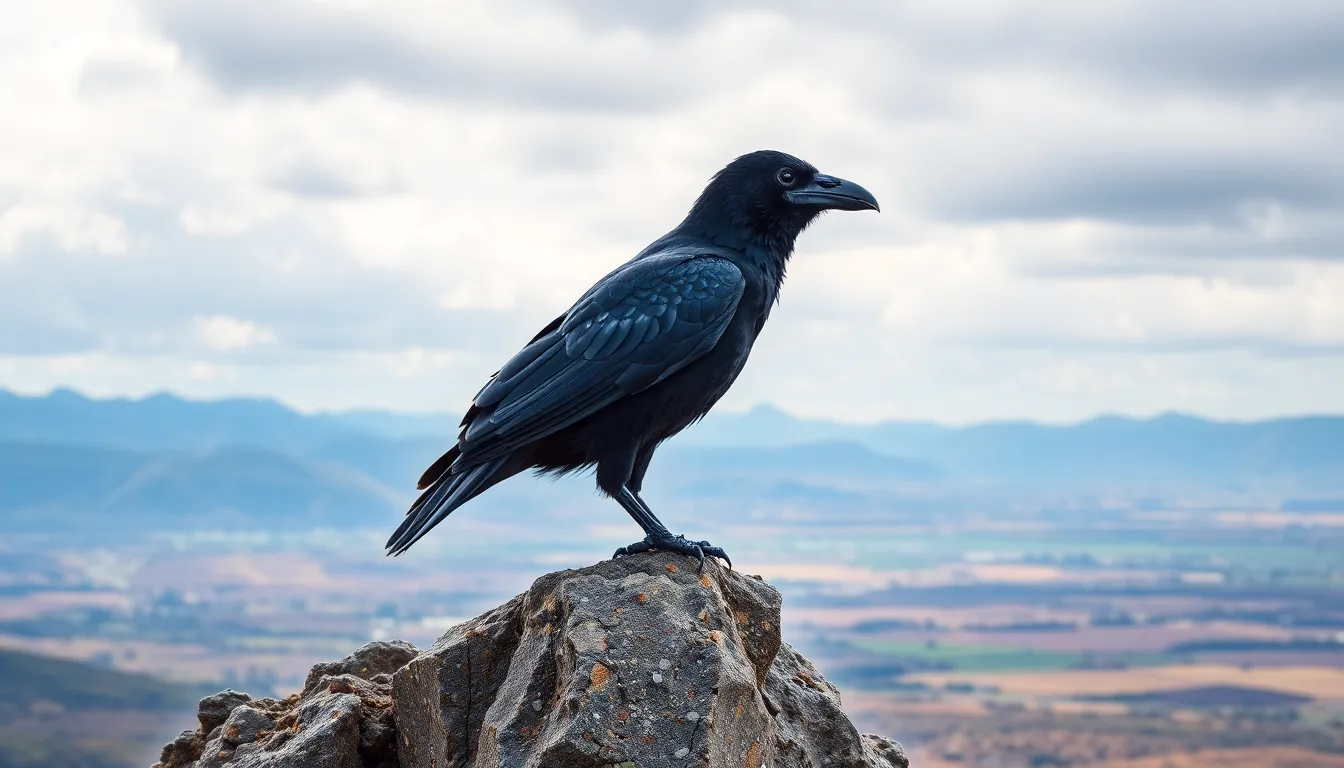
Ravens thrive across diverse ecosystems throughout the Northern Hemisphere, showcasing remarkable adaptability that extends their presence from arctic tundra to desert landscapes. These intelligent corvids have established themselves as one of the most widely distributed bird species globally.
Natural Range
North America hosts ravens across Alaska, western Canada, and the western United States, with populations extending through the Rocky Mountains into Mexico. European ravens occupy territories spanning from Scandinavia to the Mediterranean, including the British Isles, where they hold cultural significance as Tower of London guardians. Asian populations distribute across Siberia, Central Asia, the Himalayas, and parts of China and Japan.
Arctic regions support substantial raven populations, particularly in Greenland, Iceland, and northern Canada where temperatures drop below -40°F. Desert environments in the southwestern United States, North Africa, and Middle Eastern countries provide habitats for specialized raven populations that have adapted to extreme heat and water scarcity. Mountain ranges including the Alps, Pyrenees, and Caucasus Mountains maintain stable raven communities at elevations exceeding 16,000 feet.
Preferred Environments
Open landscapes with scattered trees offer ravens optimal hunting grounds and nesting sites, particularly in grasslands, prairies, and agricultural areas. Coastal regions attract these birds due to abundant food sources including marine carrion, shellfish, and seabird eggs. Forest edges and woodland clearings provide the perfect balance of cover and open space that ravens require for their complex social behaviors.
Urban environments increasingly support raven populations, with cities like Anchorage, Seattle, and London reporting growing numbers of these adaptable birds. Mountainous terrain appeals to ravens for its thermal updrafts that enhance their soaring abilities and the varied microclimates that support diverse prey species. Tundra regions offer ravens access to caribou herds, providing consistent carrion sources during migration periods.
Ravens demonstrate remarkable habitat flexibility, occupying territories ranging from sea level to 20,000 feet elevation and thriving in annual precipitation zones from less than 5 inches to over 200 inches.
Diet and Feeding Behavior
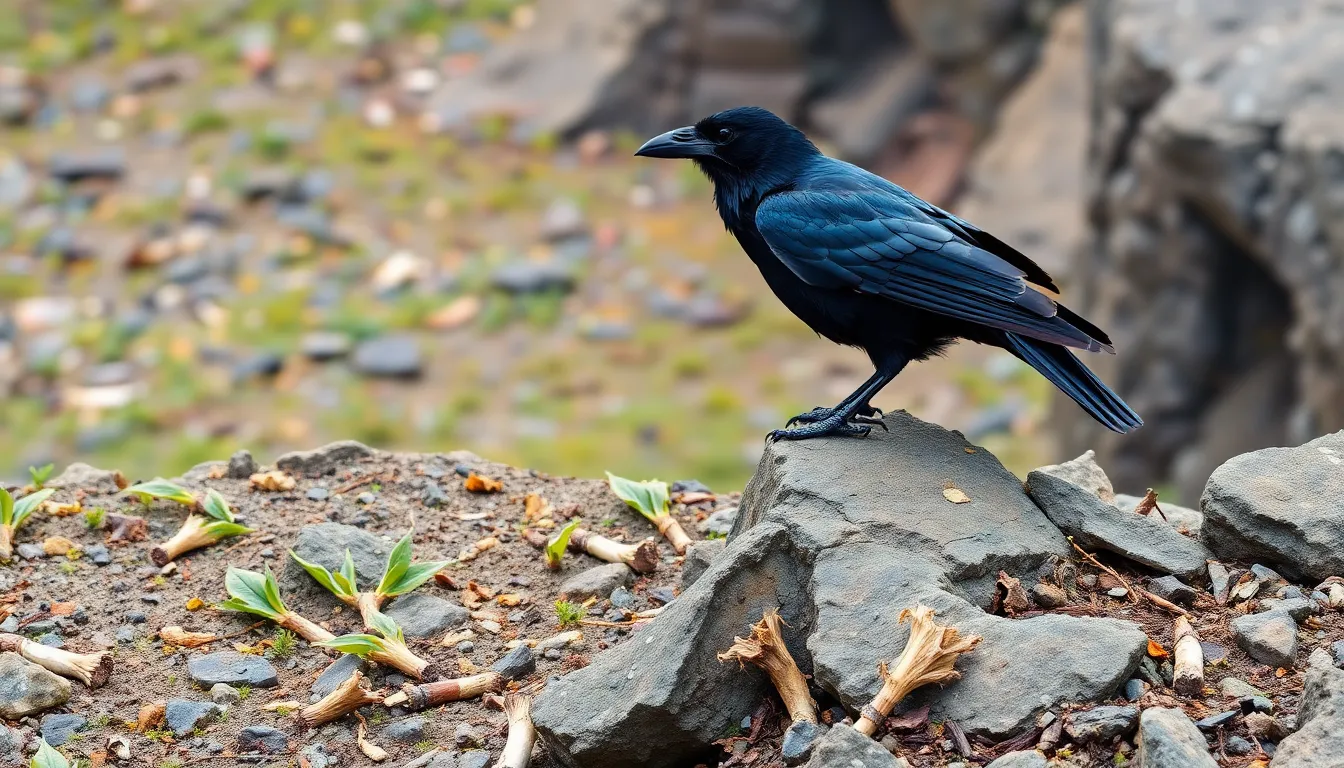
Ravens demonstrate exceptional dietary flexibility that directly contributes to their success across diverse habitats worldwide. These intelligent corvids consume virtually anything they encounter, adapting their feeding strategies to seasonal availability and environmental conditions.
Omnivorous Nature
Ravens exhibit one of the most diverse diets among bird species, consuming both plant and animal matter with equal enthusiasm. Carrion forms the foundation of their diet, with ravens frequently feeding on roadkill, deceased wildlife, and marine animals washed ashore. Small mammals such as rodents, rabbits, and ground squirrels represent important protein sources, particularly during breeding season.
Insects including beetles, grasshoppers, and caterpillars provide essential nutrients throughout warmer months. Birds’ eggs and nestlings face regular predation from ravens, who systematically raid colonies of seabirds, waterfowl, and smaller songbirds. Fish become primary targets near coastal areas and rivers, where ravens wade in shallow water or steal catches from other predators.
Plant materials comprise roughly 30% of their annual diet, featuring berries, fruits, seeds, and nuts. Grains from agricultural areas attract large flocks during harvest seasons, while garbage and human food waste supplement urban populations’ nutritional needs.
Hunting and Foraging Techniques
Ravens employ sophisticated hunting strategies that showcase their remarkable intelligence and adaptability. Cooperative hunting occurs frequently, with pairs or family groups coordinating attacks on larger prey items such as young mammals or injured animals.
Ground foraging represents their most common feeding behavior, where ravens systematically search territories using their powerful bills to overturn rocks, probe soil, and extract hidden prey. Walking patterns cover extensive areas methodically, allowing ravens to locate food sources other birds miss entirely.
Aerial hunting techniques include diving attacks on small mammals and harassment of other birds to force them to drop food items. Ravens master kleptoparasitism by following wolves, bears, and human hunters to claim portions of fresh kills.
Tool usage enhances their foraging efficiency considerably, with ravens breaking shells against rocks, using sticks to extract insects from bark, and dropping hard objects from heights to crack open shellfish. Caching behavior involves storing surplus food in multiple locations, creating food reserves that sustain them during scarce periods.
Social foraging networks allow ravens to share information about abundant food sources through complex vocalizations and behavioral signals, maximizing feeding success for entire communities.
Intelligence and Problem-Solving Abilities
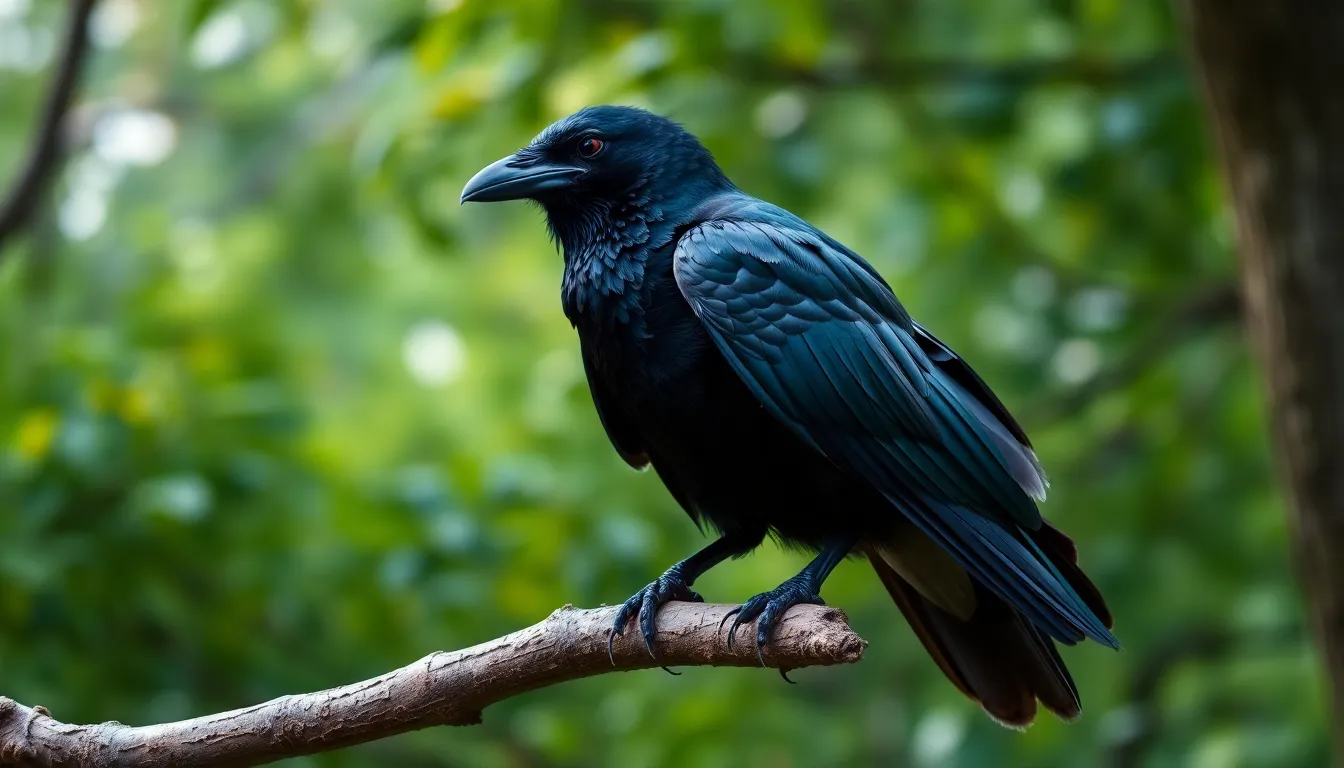
Ravens demonstrate cognitive abilities that rival those of primates and young children. These remarkable birds process complex information and adapt their behavior based on experience and environmental changes.
Cognitive Skills
Ravens exhibit working memory capabilities that allow them to remember sequences of up to 7 items. Research conducted at the University of Cambridge shows ravens can plan for future events up to 17 hours in advance, selecting tools they’ll need for tasks that aren’t immediately present. These birds recognize themselves in mirrors, a trait shared with only a few animal species including great apes and dolphins.
Ravens understand cause-and-effect relationships and demonstrate abstract thinking when solving multi-step problems. Scientists at the Max Planck Institute documented ravens successfully completing the “Aesop’s fable” water displacement task, dropping stones into tubes to raise water levels and access floating rewards. Their spatial reasoning allows them to navigate complex three-dimensional environments and remember the locations of hundreds of cached food items across vast territories.
Studies reveal ravens can categorize objects by color, shape, and material properties. They grasp concepts of “same” and “different” when presented with matching tasks, often outperforming 5-year-old children in certain cognitive assessments. Ravens also exhibit numerical abilities, distinguishing between quantities up to 4 without training.
Tool Use and Learning
Ravens fashion tools from various materials including twigs, leaves, and wire to extract food from hard-to-reach places. Wild ravens in New Caledonia create hooked tools by bending and shaping plant fibers, demonstrating sophisticated manufacturing skills. These birds modify existing objects to better suit exact tasks, showing innovation rather than just instinctive behavior.
Laboratory experiments reveal ravens can learn multi-step tool sequences within 30 minutes of first exposure. They understand that certain tools work better for exact tasks and actively select appropriate implements before beginning their work. Ravens observe and learn from other ravens’ tool-making techniques, passing knowledge through social learning networks.
Betty, a captive raven at Oxford University, gained international recognition for spontaneously bending straight wire into hooks to retrieve food from vertical tubes. This behavior occurred without prior training or observation of similar techniques. Ravens retain learned tool-use skills for months without practice and can apply these techniques to novel situations with different materials and contexts.
Social Behavior and Communication
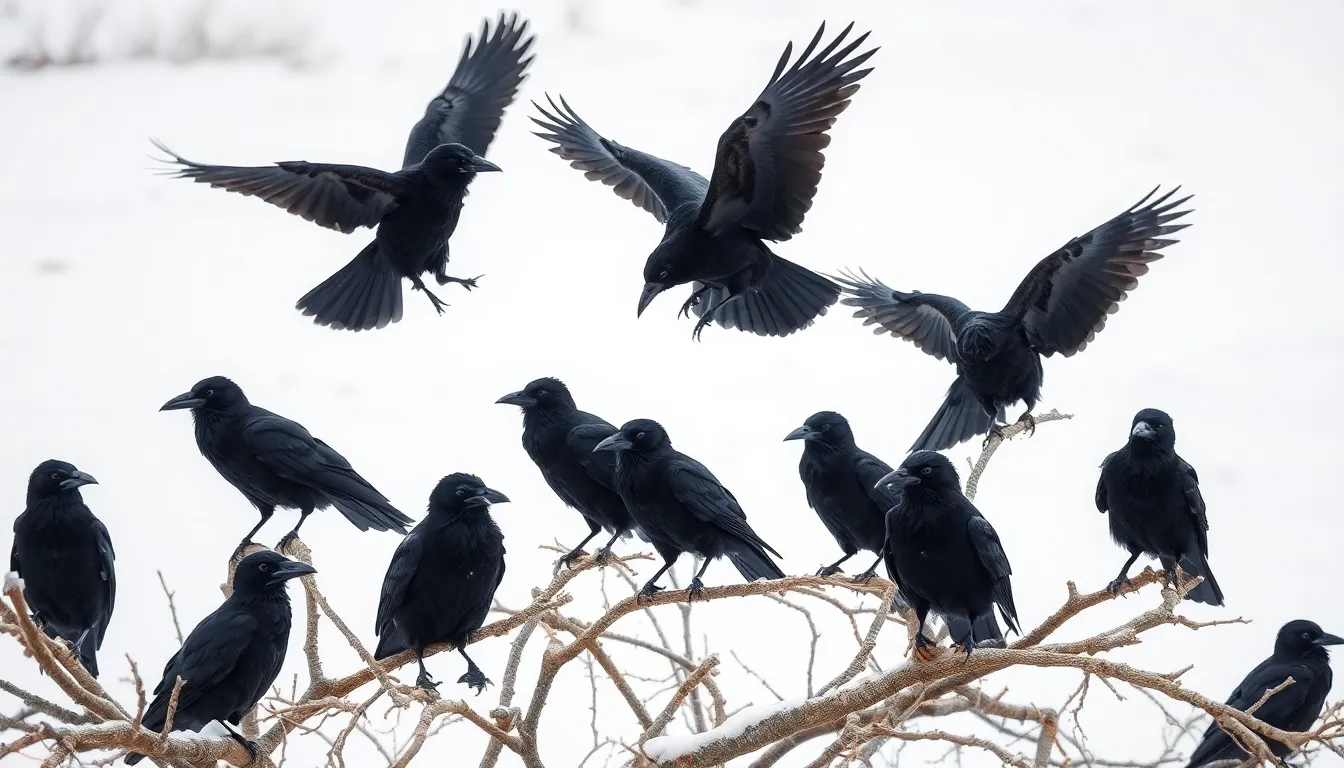
Ravens operate within sophisticated social networks that demonstrate remarkable organizational complexity and communication depth. These intelligent corvids establish intricate relationships that extend far beyond simple flocking behavior.
Flock Dynamics
Ravens form ever-changing social groups that range from mated pairs to large congregations of 400 individuals during winter months. Young ravens gather in juvenile flocks before reaching sexual maturity at 3 to 4 years old. These groups exhibit distinct hierarchical structures where dominant birds claim access to prime food sources and roosting locations.
Territorial pairs defend areas spanning 17 to 44 square kilometers during breeding season. Non breeding ravens create temporary alliances that shift based on food availability and seasonal changes. Roosting sites become social gathering points where ravens share information about food locations through coordinated behaviors and vocal exchanges.
Dominance displays include wing spreading, bill pointing, and aggressive posturing that establish pecking orders within groups. Subordinate ravens demonstrate submission through crouched postures and exact vocalizations. Play behavior strengthens social bonds as ravens engage in aerial acrobatics, object manipulation games, and mock fighting sequences.
Vocalizations and Language
Ravens produce over 30 distinct vocalizations that serve exact communicational functions within their social framework. Their signature “krawk” call varies in pitch, duration, and intensity to convey different messages about territory, alarm, or food discovery.
Soft rattling sounds help intimate communication between mated pairs and close companions. Clicking noises indicate contentment during feeding or grooming activities. Bell like tones emerge during playful interactions and courtship rituals.
Context exact calls include danger warnings that distinguish between ground predators and aerial threats. Food announcement calls attract other ravens to abundant resources while territorial calls warn intruders to maintain distance. Juveniles develop their vocal repertoire through mimicry and practice sessions that can last several months.
Ravens demonstrate vocal learning abilities by incorporating sounds from their environment including human speech patterns, mechanical noises, and other bird species’ calls. Wild ravens living near human settlements often adopt exact words or phrases they hear repeatedly. Their syrinx structure allows precise control over sound production enabling complex vocal modulations that enhance their communicative range.
Breeding and Life Cycle
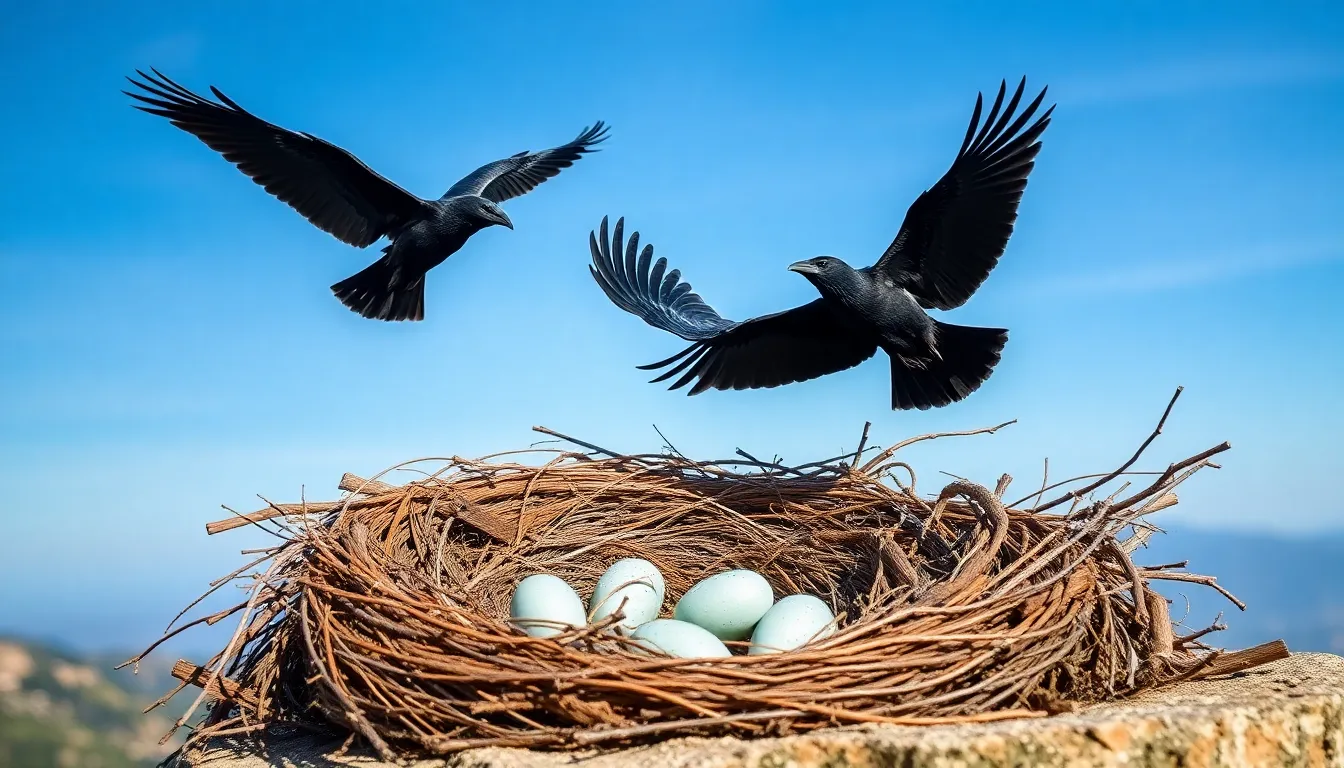
Ravens demonstrate complex reproductive behaviors that reflect their advanced intelligence and strong social bonds. These remarkable birds engage in elaborate courtship rituals and invest significantly in raising their offspring.
Mating Rituals
Ravens form monogamous pair bonds that often last for life, typically reaching sexual maturity at 3 to 4 years of age. Males initiate courtship displays through dramatic aerial acrobatics, performing barrel rolls, dives, and synchronized flights with potential mates. These displays demonstrate the male’s physical fitness and flying prowess to attract females.
Courtship behaviors extend beyond flight demonstrations to include gift giving, where males present food items to females as tokens of their ability to provide. Ravens also engage in mutual preening sessions, strengthening their pair bond through gentle grooming of each other’s head and neck feathers. Vocal exchanges play a crucial role during courtship, with pairs developing unique call patterns that serve as their personal communication system.
The breeding season varies by geographic location, typically occurring between March and July in temperate regions. Northern populations begin breeding later than their southern counterparts, adapting to local climate conditions and food availability.
Nesting and Offspring Care
Ravens construct their nests in elevated locations such as cliff ledges, tall trees, or human-made structures like bridges and buildings. Both partners collaborate in nest construction, creating a substantial platform measuring 4 to 5 feet across using sticks, bark, and other available materials. The nest interior features a cup-shaped depression lined with soft materials including moss, animal hair, and feathers.
Females lay 3 to 7 eggs during a single breeding season, with the average clutch size being 4 to 5 eggs. The incubation period lasts approximately 20 to 25 days, during which the female remains on the nest while the male provides food and protection. Eggs display a pale blue-green coloration with brown speckles, measuring about 2 inches in length.
Chicks hatch with closed eyes and minimal feathering, requiring intensive parental care for survival. Both parents share feeding responsibilities, making up to 100 feeding trips per day to satisfy their offspring’s nutritional needs. Young ravens remain in the nest for 5 to 7 weeks before fledging, developing their distinctive black plumage during this period.
After fledging, juvenile ravens continue to depend on their parents for an additional 2 to 6 months while learning essential survival skills. Parents teach their offspring hunting techniques, social behaviors, and territorial boundaries through direct instruction and observation. Family groups often remain together through the first winter, with young ravens gradually gaining independence as they master foraging and social skills.
Ravens typically produce one brood per year, though pairs may attempt a second clutch if the first breeding attempt fails early in the season. Their reproductive success depends heavily on environmental factors including food availability, weather conditions, and nesting site security.
Cultural Significance and Mythology
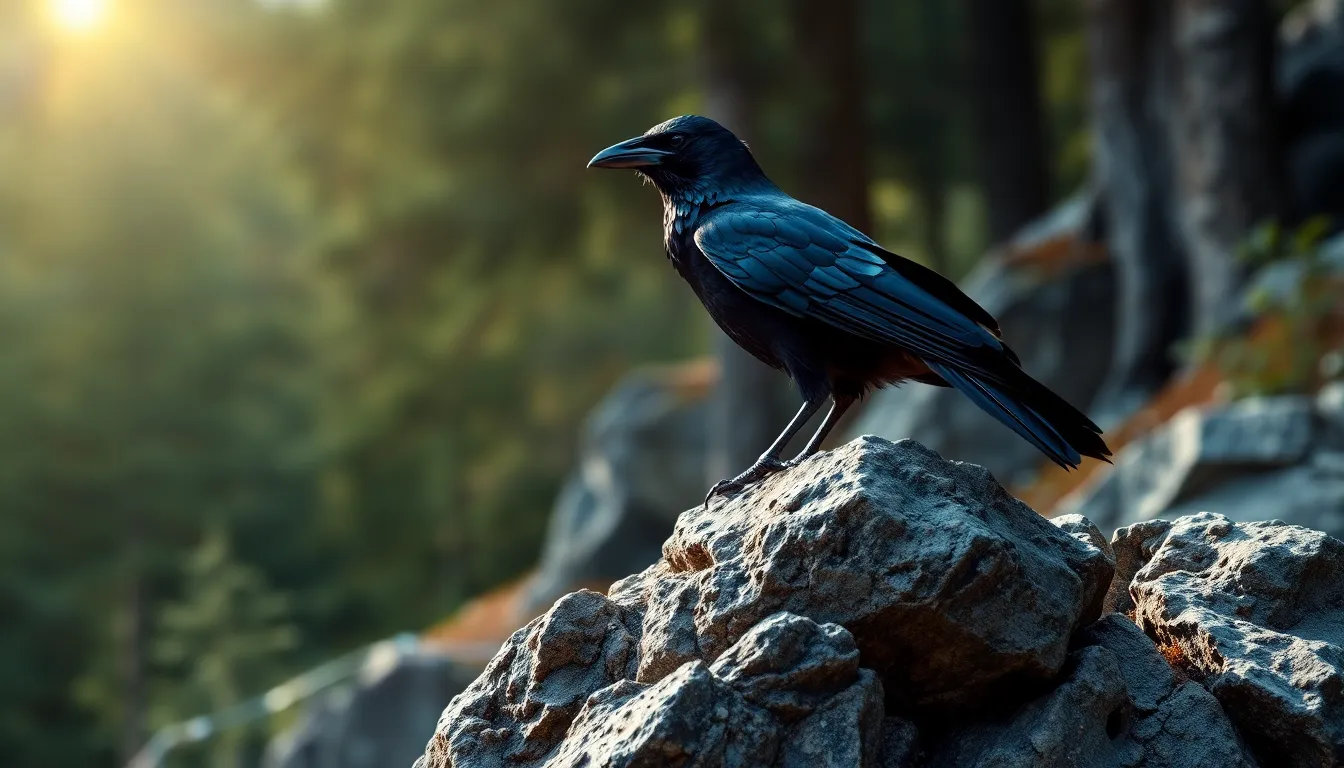
Ravens occupy a unique position in human culture across civilizations, serving as powerful symbols that transcend geographical boundaries and historical periods. These remarkable birds have woven themselves into the fabric of mythology, folklore, and contemporary symbolism through their intelligence and mysterious presence.
Folklore and Legends
Norse mythology presents ravens as divine messengers through Huginn and Muninn, Odin’s faithful companions who fly across the nine realms gathering information. These ravens represent thought and memory respectively, returning each day to whisper secrets into the All-Father’s ears. Germanic tribes viewed ravens as battlefield guides, believing these birds could predict victory or defeat by their flight patterns over armies.
Celtic traditions paint ravens as shapeshifters and guardians of otherworldly knowledge. The Morrigan, Celtic goddess of war and fate, often appeared in raven form during battles, choosing which warriors lived or died. Welsh legends describe Bran the Blessed, whose name means raven, as a giant king whose severed head protected Britain from invasion when buried beneath the Tower of London.
Native American cultures across tribes assign ravens roles as creators and tricksters simultaneously. Pacific Northwest peoples credit Raven with stealing fire from the gods and bringing light to humanity. Inuit stories portray ravens as clever problem solvers who outwit other animals through cunning and intelligence. Cherokee traditions describe ravens as messengers between the physical industry and spirit area.
Greek mythology positions ravens as Apollo’s sacred birds, originally white but turned black as punishment for bringing bad news. Roman augurs interpreted raven calls and flight patterns to predict future events, considering their presence during important decisions as divine guidance. Japanese folklore features the three-legged crow Yatagarasu as a divine messenger guiding emperors and heroes on crucial missions.
Modern Symbolism
Contemporary culture maintains ravens’ symbolic power while expanding their meanings across multiple contexts. Gothic literature, exemplified by Edgar Allan Poe’s “The Raven,” uses these birds to represent death, loss, and psychological torment. Horror films frequently feature ravens as omens of supernatural events or harbingers of doom approaching main characters.
Sports teams worldwide adopt raven imagery to convey intelligence, strength, and strategic thinking. The Baltimore Ravens NFL team chose their mascot to reflect the literary heritage of Edgar Allan Poe while emphasizing tactical prowess on the field. Professional esports organizations use raven symbols to represent cunning gameplay and strategic superiority over opponents.
Military units incorporate raven emblems to symbolize reconnaissance capabilities and intelligence gathering. Special forces units particularly favor raven insignia because these birds represent stealth, adaptability, and the ability to operate effectively in diverse environments. Intelligence agencies sometimes use raven symbolism to represent their information gathering and analytical capabilities.
Corporate branding leverages ravens’ reputation for intelligence and problem solving in technology and consulting sectors. Companies specializing in artificial intelligence, data analysis, and strategic planning frequently adopt raven imagery to communicate their analytical capabilities and innovative thinking. Fashion brands use raven motifs to convey elegance, mystery, and sophisticated aesthetic sensibilities.
Environmental movements embrace ravens as symbols of network health and biodiversity conservation. These birds represent the interconnectedness of natural systems and the importance of apex species in maintaining ecological balance. Wildlife protection organizations use raven imagery to promote habitat conservation and raise awareness about intelligent wildlife species deserving protection.
Conservation Status and Threats
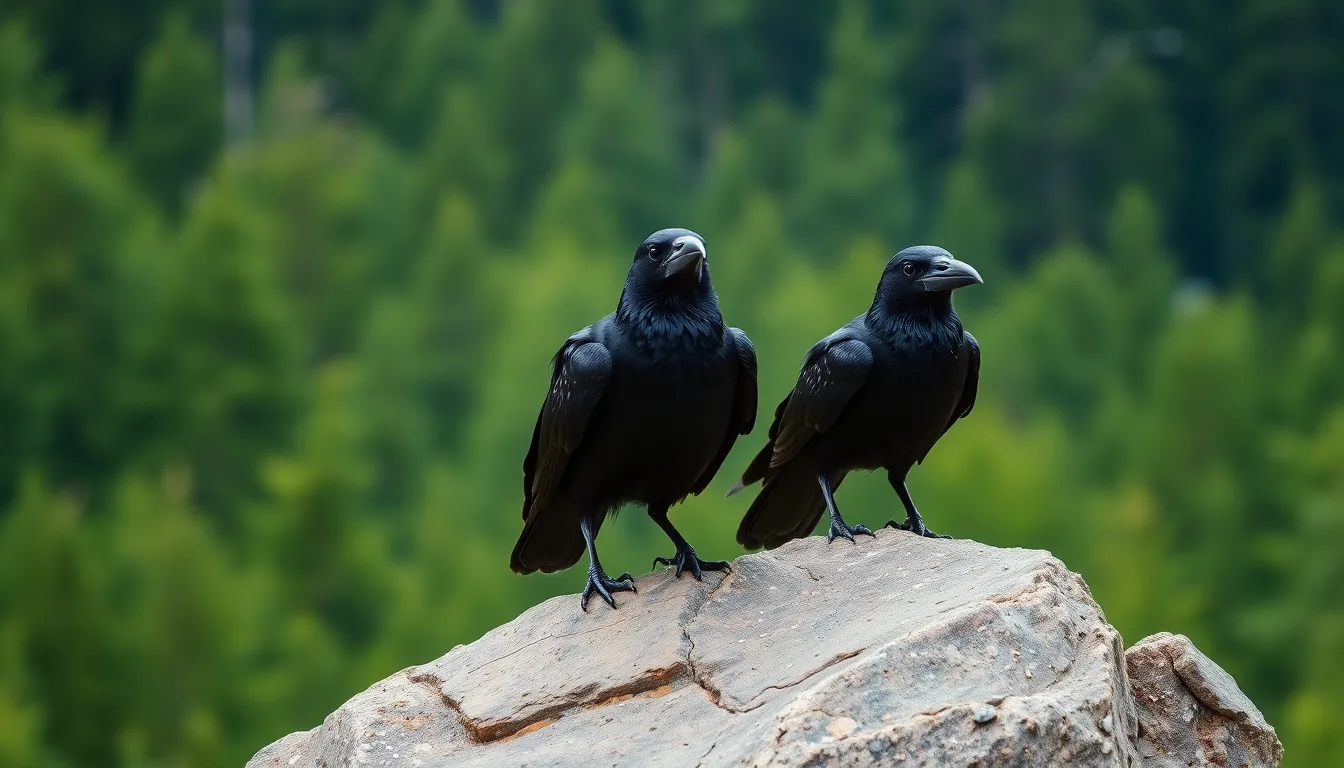
Ravens currently maintain stable populations across most of their global range, earning them a “Least Concern” status from the International Union for Conservation of Nature (IUCN). North American raven populations number approximately 16 million breeding pairs, while European populations exceed 2.5 million pairs. These remarkable birds have demonstrated exceptional resilience compared to many other corvid species.
Climate change poses emerging challenges for raven populations, particularly those in arctic regions where warming temperatures alter traditional food sources. Mountain-dwelling ravens face habitat shifts as treelines move upward by 100-200 feet per decade in certain regions. Desert populations experience increased stress from extreme heat events that now occur 40% more frequently than in previous decades.
Human encroachment significantly impacts raven nesting sites and foraging territories. Urban development destroys approximately 15,000 acres of suitable raven habitat annually in North America alone. Power line collisions kill an estimated 5,000-8,000 ravens yearly across their range. Wind turbines contribute additional mortality, though ravens show greater avoidance behaviors than many other bird species.
| Threat Category | Annual Impact | Geographic Scope |
|---|---|---|
| Habitat Loss | 15,000 acres destroyed | North America |
| Power Line Collisions | 5,000-8,000 deaths | Global |
| Pesticide Poisoning | 2,000-3,000 deaths | Agricultural regions |
| Illegal Persecution | 1,500-2,000 deaths | Rural areas |
Agricultural practices introduce pesticide exposure risks that accumulate in raven food chains. Rodenticides consume small mammals that ravens frequently scavenge, leading to secondary poisoning in 8-12% of monitored populations. Organochlorine residues still appear in raven eggs even though bans implemented decades ago, indicating persistent environmental contamination.
Regional populations face varying conservation pressures across different continents. European ravens recovered strongly after protection laws enacted in the 1970s increased breeding pairs by 300% in countries like England and Wales. Asian populations remain less studied, though habitat fragmentation threatens subspecies in Japan and parts of China. Island populations show particular vulnerability, with some Caribbean subspecies experiencing declining numbers due to hurricane impacts and invasive species.
Ravens adapt more successfully to environmental changes than most bird species due to their intelligence and dietary flexibility. Urban raven populations actually increase in many cities, growing by 2-4% annually as they exploit new food sources and nesting opportunities. Their cognitive abilities enable rapid behavioral adjustments to human activities and environmental modifications.
Protection efforts focus primarily on habitat preservation and reducing human-caused mortality. Wildlife corridors maintain connectivity between raven territories, while modified power line designs decrease collision risks by up to 60%. Educational programs reduce illegal persecution by highlighting ravens’ ecological benefits and dispelling harmful myths about their impact on livestock and crops.
Conclusion
Ravens stand as extraordinary creatures that challenge our understanding of avian intelligence and adaptability. Through our exploration we’ve discovered that these remarkable birds possess cognitive abilities rivaling those of primates while maintaining the resilience to thrive across diverse global environments.
Their success stems from a perfect combination of physical prowess social sophistication and mental flexibility. From their tool-making capabilities to their complex communication systems ravens demonstrate that intelligence in the animal kingdom extends far beyond traditional expectations.
As we continue to study these fascinating birds we’re reminded of the importance of protecting their habitats and respecting their place in our ecosystems. Ravens aren’t just survivors—they’re innovators that deserve our admiration and conservation efforts for generations to come.
Frequently Asked Questions
How intelligent are ravens compared to other animals?
Ravens exhibit intelligence comparable to primates and young children. They demonstrate advanced problem-solving skills, can plan for future events, understand cause-and-effect relationships, and possess working memory capabilities. Research shows they can categorize objects, exhibit numerical abilities, recognize themselves in mirrors, and even fashion tools from various materials to solve complex problems.
What do ravens look like and how big are they?
Ravens are among the largest corvids, measuring 24-27 inches in length and weighing 1.5-4.4 pounds, with a wingspan of 46-53 inches. They have a robust build with powerful chest muscles, a massive bill that serves as a multi-tool, wedge-shaped tail, and stunning plumage that shifts between deep black and iridescent hues.
Where do ravens live and what habitats do they prefer?
Ravens are remarkably adaptable and thrive across diverse ecosystems in the Northern Hemisphere, from arctic tundra to desert landscapes. They inhabit areas from Alaska to Mexico in North America and from Scandinavia to the Mediterranean in Europe. They prefer open landscapes, coastal regions, urban areas, and mountainous terrains.
What do ravens eat and how do they find food?
Ravens are omnivores with exceptional dietary flexibility, consuming carrion, small mammals, insects, birds’ eggs, berries, and nuts. They use sophisticated hunting strategies including cooperative hunting, ground foraging, and tool use. Ravens also cache surplus food and form social networks to share information about food sources through vocalizations.
How do ravens communicate with each other?
Ravens have sophisticated communication systems with over 30 distinct vocalizations, each serving specific functions from alarm calls to food announcements. They possess vocal learning abilities that allow them to mimic environmental sounds, including human speech. Ravens also use body language and behaviors to communicate within their complex social hierarchies.
Do ravens mate for life and how do they raise their young?
Ravens typically form monogamous pair bonds that often last for life. Males perform elaborate courtship displays to attract females, and both parents collaborate in nest construction and share parental responsibilities. They work together to feed their chicks intensively after hatching, with environmental factors playing a crucial role in reproductive success.
What is the cultural significance of ravens in different societies?
Ravens hold powerful symbolic meaning across various civilizations. Norse mythology depicts them as divine messengers, Celtic traditions view them as shapeshifters and knowledge guardians, and Native American cultures portray them as creators and tricksters. Modern culture continues to embrace ravens as symbols of intelligence, strength, and ecological balance.
Are ravens endangered or threatened?
Ravens currently maintain stable populations with “Least Concern” status from the IUCN. There are approximately 16 million breeding pairs in North America and over 2.5 million in Europe. However, they face challenges from climate change, habitat loss, urban development, power line collisions, and pesticide exposure, making conservation efforts important.

